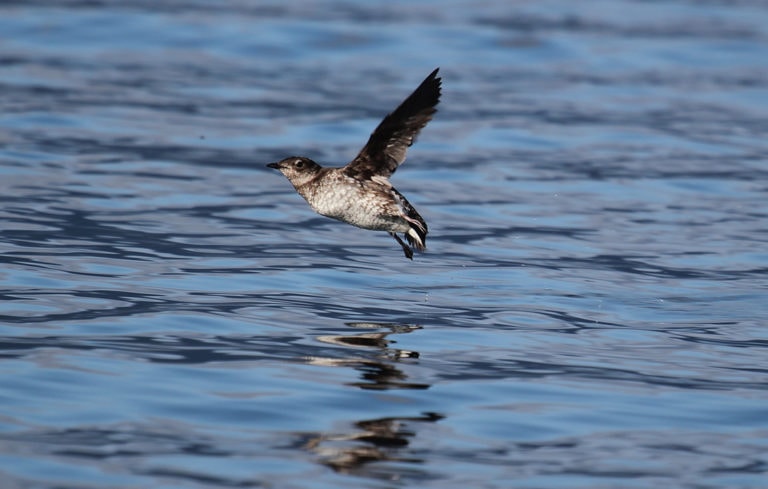
The marbled murrelet is a small, elusive seabird that nests in old-growth forest. Photo by Robin Corcoran/USFWS
It’s safe to say virtually all life on Earth depends on the symbiosis between land and ocean. However, with some species, we can observe this dependence in a very tangible way and get a clear picture of why summit-to-sea connectivity is vitally important in statewide conservation efforts.
Take the marbled murrelet, for instance. This little elusive seabird spends most of its time at the ocean, where it forages for food and mates, but then comes inland to nest in forested habitat during breeding season.
“It doesn’t even have much of a migration,” says Paul Engelmeyer, who has managed Portland Audubon’s Ten Mile Creek Sanctuary, home to nesting marbled murrelets and other imperiled species, since 1990.
The marbled murrelet is about the size of a robin, and it can be found offshore along the western U.S. Coast from central California to the Aleutian Islands of Alaska. In northern Oregon, there are occupied nesting areas in Ecola State Park, Oswald West State Park, Saddle Mountain State Natural Area, and some Oregon Department of Forestry lands.
During the breeding season, adult marbled murrelets have a mottled milk-chocolate brown color, so they can easily blend into their forested environment. They change to a more distinct black-and-white coloring during the winter season.
The bird nests in old-growth coniferous forests, and they prefer larger stands—500 acres or more—where they are better protected from edge predators, or predators who encroach from outside the forest. It’s not uncommon for them to get preyed upon by crows, ravens and red-tailed hawks, which thrive in clear-cuts. They don’t build a nest, but nest on a branch or large limb that has a moss covering.
The marbled murrelet only lays one egg during the breeding season. They will incubate the egg for about 30 days; the male and female trade off every 24 hours or so. Once the chick has hatched, the adults don’t attend to the chick anymore, except to bring in their forage of small fish from the sea.
According to Deanna Lynch, with the U.S. Fish and Wildlife Service, the marbled murrelet is so mysterious because its whole life is designed to be cryptic. They change plumage to blend into their environment, whether they’re at sea or in the forest. They fly inland during the dawn and dusk hours to be less detectable to predators, and they can fly at speeds of up to 90 miles per hour.
However, through research initiatives like the Oregon Marbled Murrelet Project, we’ve been able to learn more about the species. The OSU College of Forestry initiated this long-term, comprehensive study in 2015. The mission is to provide new scientific information that advances our understanding of the breeding habitat requirements of marbled murrelets in Oregon and informs conservation and forest management planning within our coastal forests. In fact, it was OSU researched Kim Nelson who discovered the first marbled murrelet nest in Oregon in 1990. Since then, 78 nests have been located, of which, only 30 were active when found.
In California and Washington, the marbled murrelet is listed as an endangered species. In Oregon, conservation groups diligently advocated for many years to have the species uplifted from “threatened” to “endangered” because of loss of habitat, habitat fragmentation, ocean warming, and other risks to the population. If a species is listed as endangered, it prompts a monitoring strategy and recovery plan. Finally, in July 2021, the Oregon Fish and Wildlife Commission voted to reclassify the marbled murrelet’s status.
Loss of the marbled murrelet’s nesting habitat has long been an issue in Oregon, especially since they require larger forest stands and plenty of canopy connectivity to be protected from predators. If they have to nest on the edges, survivorship drops off, Paul says, adding “We’ve fragmented the landscape so significantly on public land and on private land even more.” Here is an animation tool that enables you to see the deforestation that’s occurred in watersheds across the state over the past several decades.
As a result, the goal is to identify and create blocks of high-quality habitat in the Oregon Coast Range bioregion to connect populations of marbled murrelets and give them a place to nest next to the sea—particularly one they can go back to year after year.
“We have this long-range vision of identifying those small patches that are there, protecting those patches and connecting them,” Paul says.
While marbled murrelets perfectly symbolize the importance of land-to-sea conservation, they are not the only ones who stand to benefit from this type of conservation. Other interior forest species will thrive better in larger stands as well. Meanwhile, we also know that driftwood—carried from the forest to the ocean—is an important source of food and habitat in the marine ecosystems. Salmon also spend time both in the ocean and in inland habitats.
We need to conserve both environments. Fortunately, working on the Oregon Coast, we are in a position to do just that.
Comments